Music 256A Final Project
Elena Stalnaker | Fall 2021
Sonified Tarot - Final Demo - 12/9/21
Sonified Tarot Final Video Demo (YouTube Link)
Project Description:
This is a prototype of a Past-Present-Future reading using a sonified tarot deck. I tried my best to make the reading a calming and reflective experience, and to have the sound associated with each card reflect the card's interpretation. I took the interpretations from the Wild Unkown Tarot deck's guide, and based the visuals loosely on the cards from that deck. You can click the empty card-frames under each section of the reading to draw a card for that section, and navigate between sections by clicking the text to the right of each card. You can also view the interpretation of each card by clicking the central object of the card you have drawn. You can play with the sound of each card by modifying certain parameters attached to keys on the keyboard, and the visual will respond accordingly.
Thank you's:
A huge thank you to Kunwoo and Ge for helping me throughout this project, and to Kim Krans, the creator of the Wild Unknown Tarot, which was the visual and interprative inspiration for this project.
Instructions:
1. Click the card shaped frame to draw a card for that section of the reading.
2. Click the central object of the card you have drawn to see its interpretation (based on the Wild Unkown Tarot deck's interpretation guide).
3. Click the central object again to come back to the cards name, keywords, and the button(s) that lead(s) to other parts of the reading.
4. Click words on right side of frames to move between parts of the reading.
5. To alter the sound of each card, follow instructions in top left corner of the screen.
Screenshots:
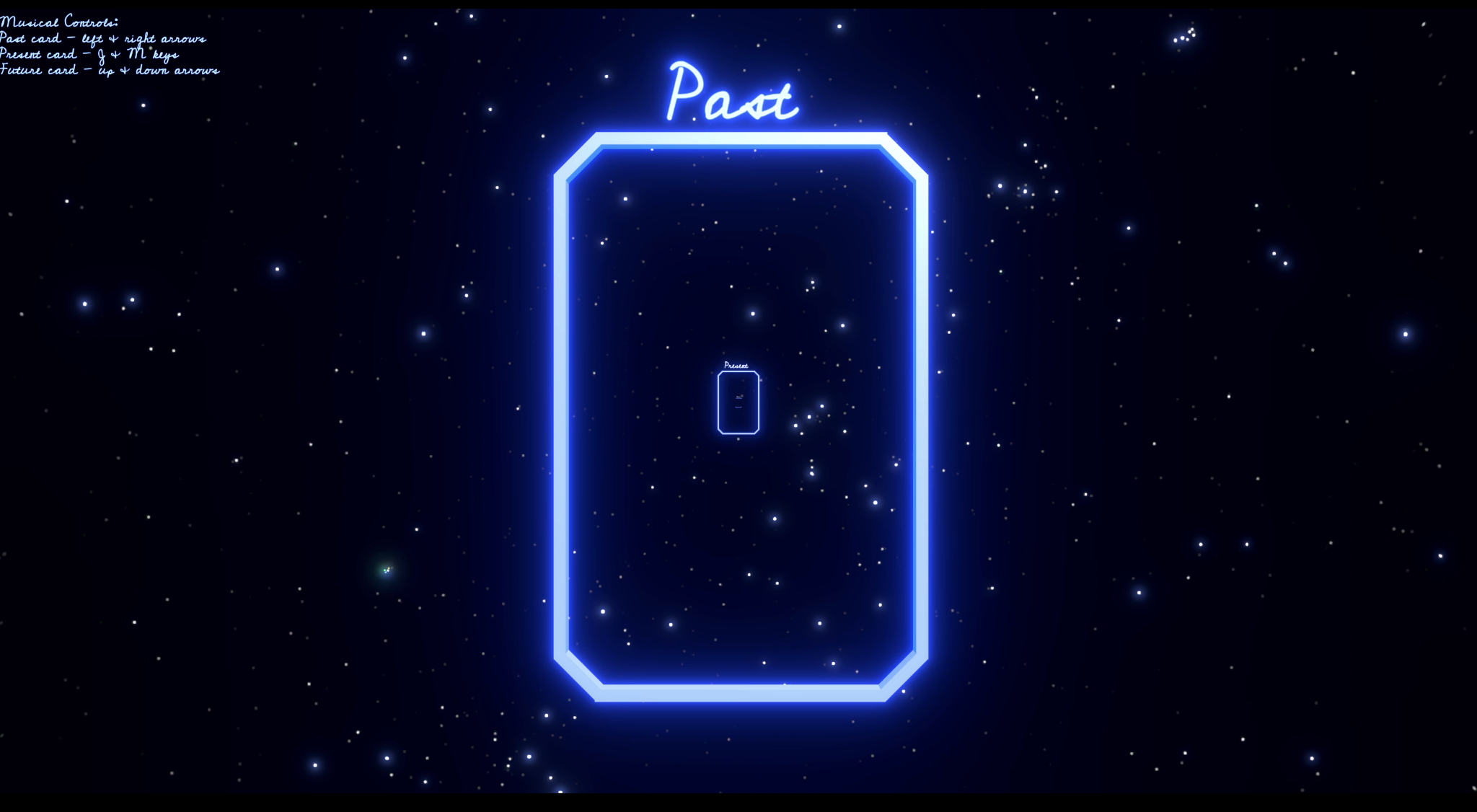
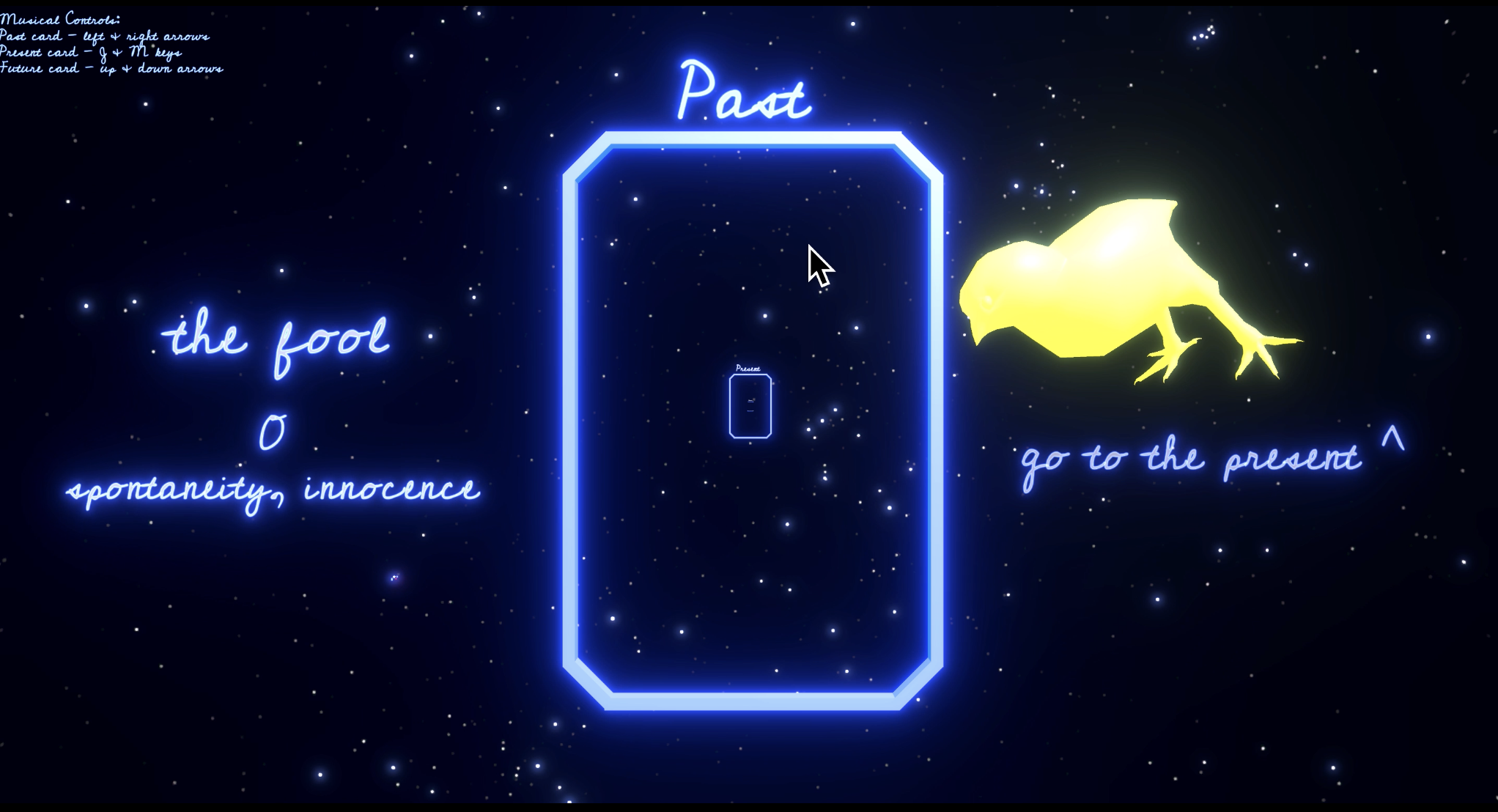
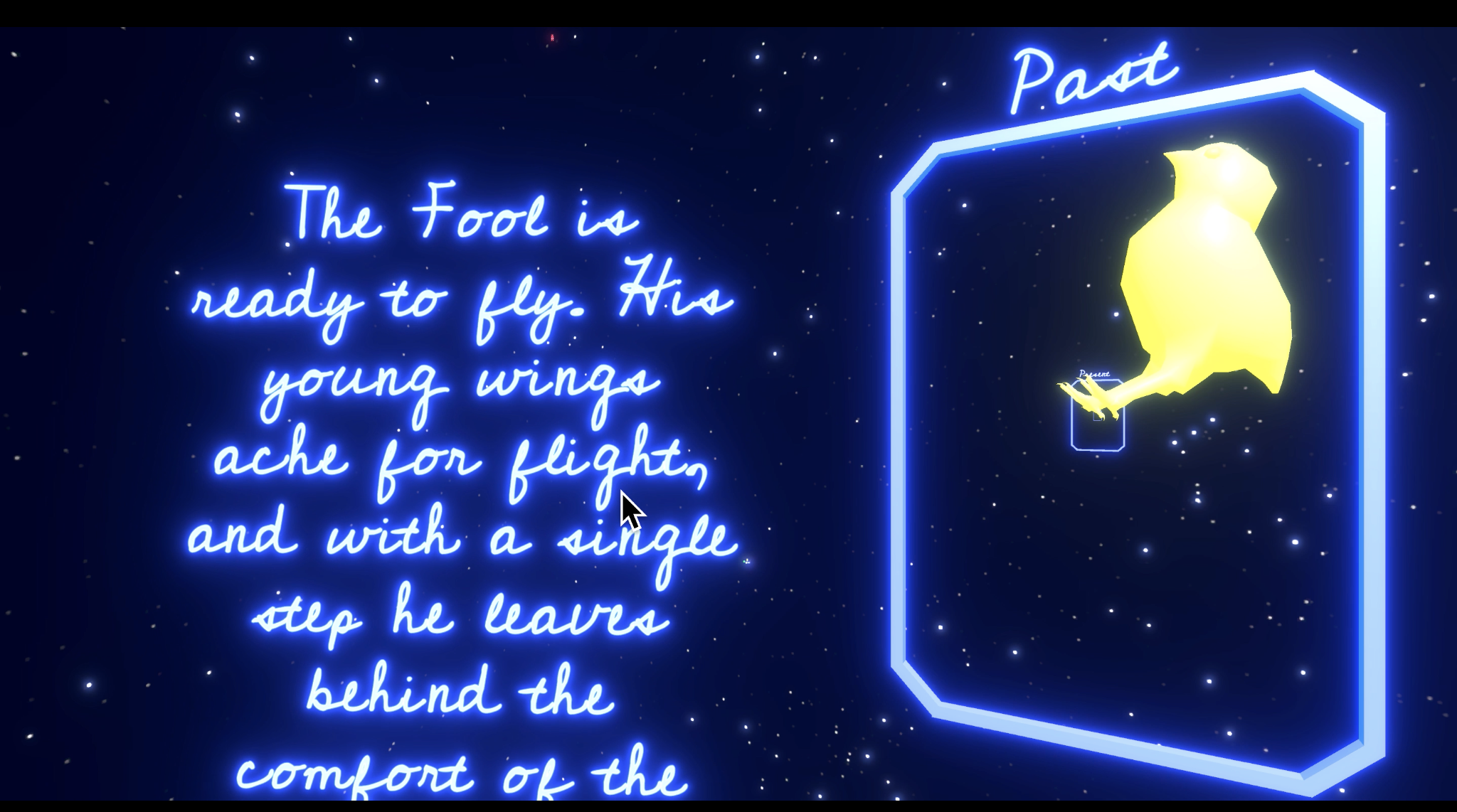

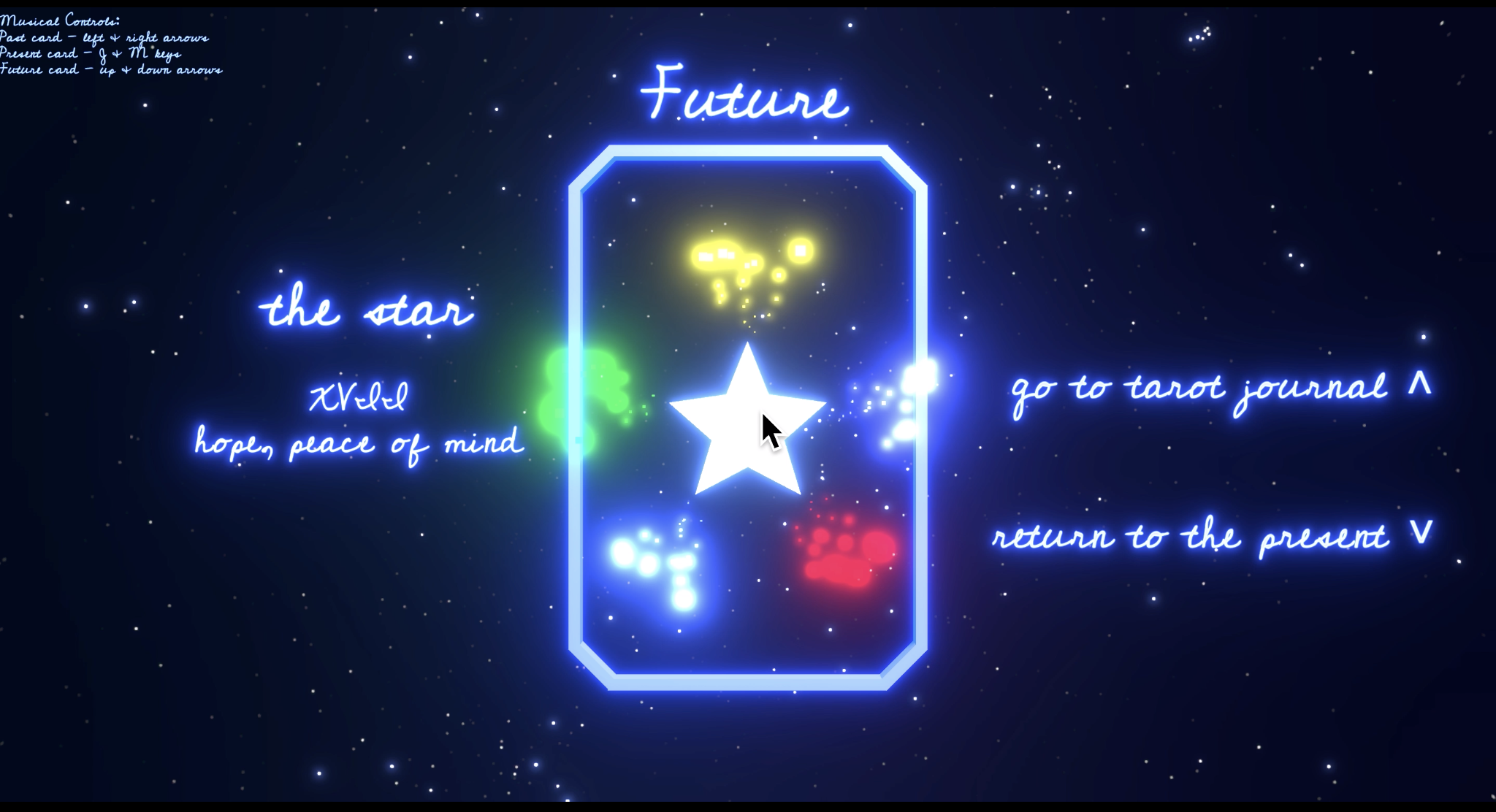

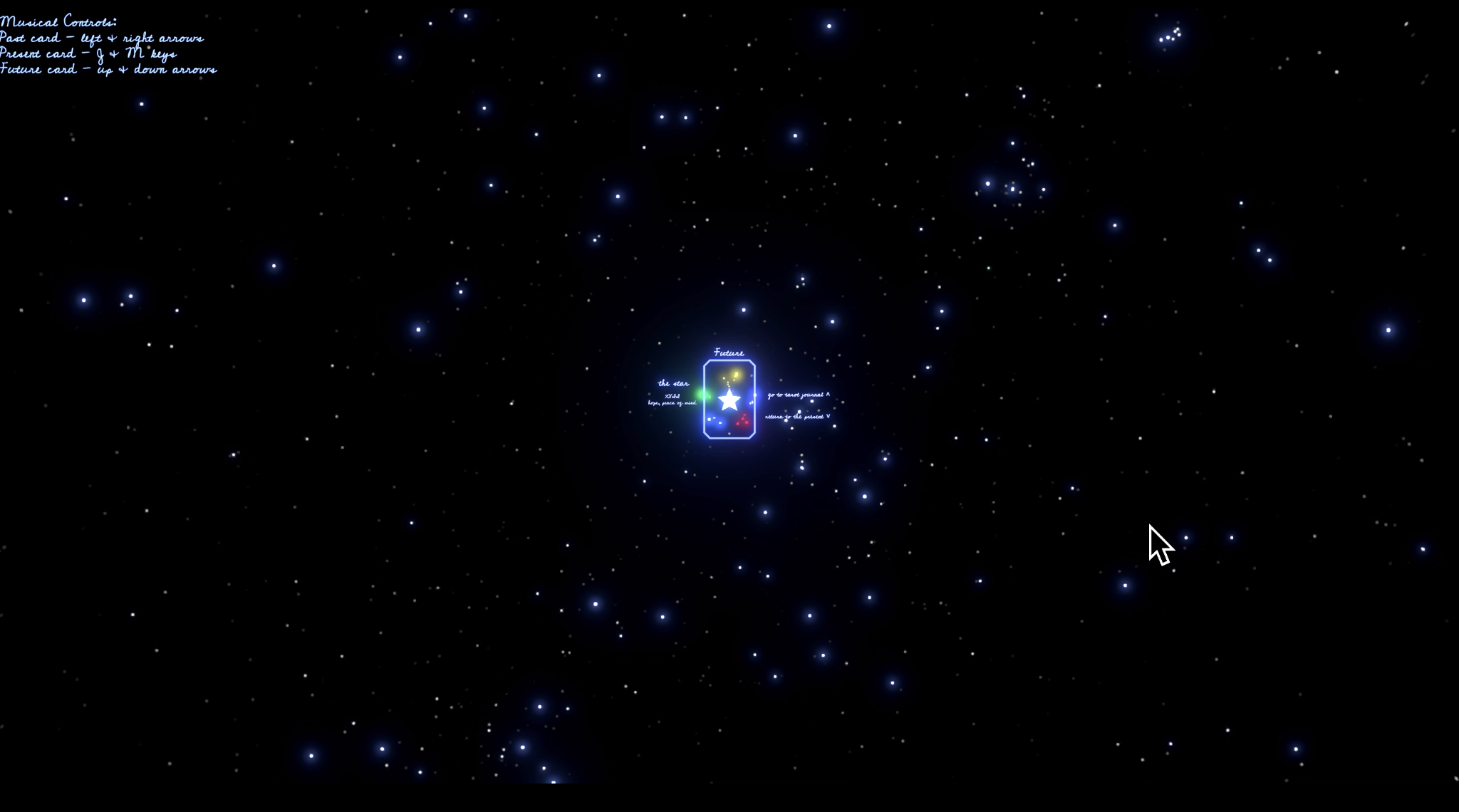
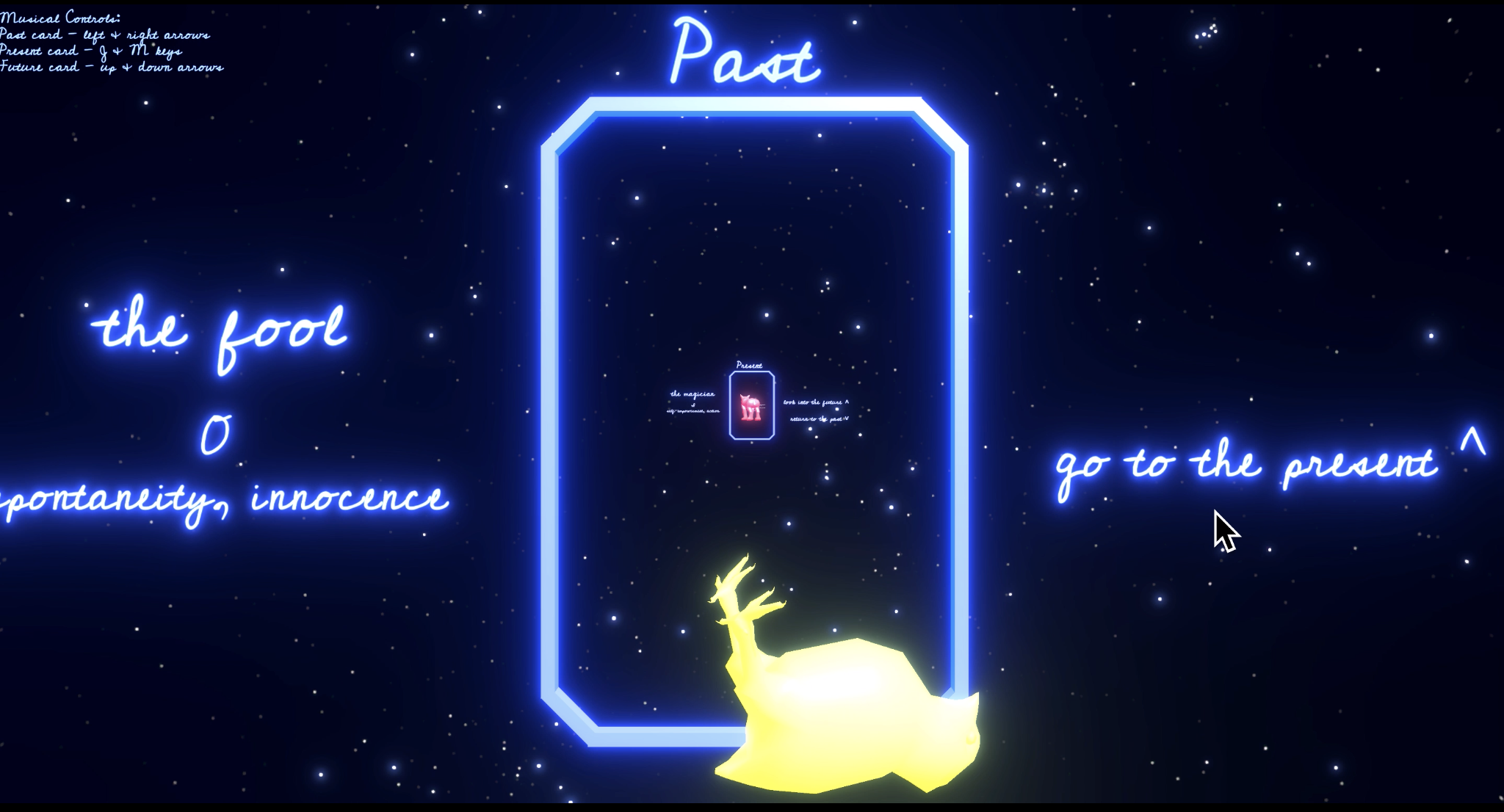
Milestone 2 - 11/29/21
Sonified Tarot Milestone 2 (YouTube Link)
Milestone 2 Notes:
For this milestone, I was able to create a mockup of a 3 card reading, with 2 of the cards having modifiable compositions. I learned that chunity communication variables work across different C# and Chuck scripts, so in order to only modify the density of one of the compositions and not all, each card needs it own set of named chunity variables. (I should really learn how to find and replace in VSCode.) I have only done this for the fool card, so the magician card spins at the same rate as the star card since the code behind each is still using the same chunity variables. I have not yet figured out how to make the arrow keys only apply to the card that is currently selected, so I have the density of the Star card tied to the up and down arrows and the density of the Fool card tied to the left and right arrows. I didn't bother adding a composition to the Magician yet since I need a more scalable method than different buttons for each card if I am eventually going to make an entire deck. I used the same mouse click script for each card, which means I had to make it pretty universal which should be helpful when I have more than three cards and am basing off of position in the reading rather than hard coded cards. Unfortunately, this also means that having mouse click selection affect the sound is going to be a doozy to code. I wasted an hour just trying to figure out how to make the selected card be louder than the others, and succeeded only in crashing Unity and needing to restart my whole computer. I still need to figure out how to manipulate reverb too; I am using NRev like Kunwoo said so there must be a way. Lastly, now that I hear multiple compositions together, I realize that it is quite overwhelming, even with just 2. I think panning based on card location might help, and I also want to make it so that when you select a card, the gain on the other cards in the reading goes to 0.
Milestone 1 - 11/19/21
Sonified Tarot Milestone 1 (YouTube Link)
Milestone 1 Notes:
The core mechanic that I completed for this milestone was the ability to modify the sound of a card using the arrow keys, and have that sonic change be reflected visually(in this case by the star's rotation speed). In the video, you can see the number for density changing in the bottom corner of the screen. When the number increases, the sound actually becomes less dense and I am pressing the down arrow and when the number decreases the sound intensifies and I am pressing the up arrow (it was easier to code it that way, and the user won't need to know it's backwards under the hood). I was hoping to be able to modify both density and reverb for this milestone, but was only able to complete density (the up and down arrows). When I try to do reverb it still crashes, or seems to do nothing. Still, I am proud of what I have accomplished so far. It was challenging to find a way to use the density parameter that sounded satisfying, and I think I managed it.
Some Design Questions I am still contemplating and would be open to suggestions about:
1. Should I give the user the freedom to clip on the high end of density/speed like they currently have? (Technically this means low numbers for density - my current lower limit is .1, but I think if I moved it up to .2 or so it wouldn't clip).
2. Since the composition for the star is heavily based on randomness, sometimes silences happen as you may have noticed in the middle of the video. For that particular spot, where it is sometimes silent and sometimes isn't, I am wondering whether silence is a bad/confusing thing, or whether it's ok that it sometimes happens there.
3. Should I have all the cards have the same parameters to modify, or have it depend on the card? (more likely the latter, since I don't think it'll be any more difficult, as I have to code each composition individually anyways.)
4. I haven't decided how I want the cards to be "drawn." My original idea was combining with my second final project idea and having it be a "walk through the woods and open little doors to draw cards" kind of thing, but I'm now realizing that would be a ton of extra work, so I am open to other suggestions.
5. For that matter, I haven't decided how I want the cards to be "flipped" after they are drawn. That could be simple though, and actually probably wouldn't make sense as a mechanic since I am making them see through.
Goals for Milestone 2 / the rest of the project:
I have a lot of other core mechanics still to figure out. Drawing cards as mentioned above, positioning them into different reading shapes, how & when to display/not display information associated with the cards. I also just need to make more cards in addition to The Star. I plan to start with the Major Arcana (the cards in the tarot deck that don't have suits and have more individual personality) and just make as much of it as I can. As for reading types, I think for this project I don't wanna get too fancy and I'll just focus on one card and 3 card readings.
Final Project Brainstorm - 11/10/21
Idea 1: Song/Lyric Loom

Melodic and lyrical fragment organizing tool - loom of threads, each thread a recording of some scrap of melody or words - recordings, uploaded or done directly, become undulating threads (like a waveform? would want it to be slower for visual effect.) Then you can weave them together on the loom, which would probably look like waveforms stretching out to become taut (or maybe longer and narrower and faster?) and literally weaving together like rows of yarn (could attach them to the loom with a shuttle?). Could have lyric fragments start out as colorless and then melodic fragments give them a color when you attach them to eachother... Not sure how the lyrics would fit into the melodic tapestry exactly. I think that since you wouldn't need that many threads to make a song compared to how many you'd need to make a tapestry, would need to either have each chunk of melodu become a chunk of fabric when you put it on th eloom, or have the melodies be dye rather than threads, and have them soak into the fabric when you add them to the song. Could also have some kind of chuck instrument in the same room if you aren't vocally inclined, or need to consult an instrument for whatever reason, so you could also generate melody fragments on that. Would be cool to have flexible tuning. Melody fragments could be represented as clouds of color using a particle system that float around the room.
Idea 2: Night Trees

Game where you wander through the canopy of a forest at night, and the sounds you find or choose follow you, creating a spooky yet comforting symphony of forest noises (and actual melodies or musical textures as well). Break a branch, and the sound loops like a beat. Open a tiny door in a tree trunk, and a chorus of tiny voices will pour out on a mist of golden steam. Maybe you come across a lake, or a monster, or a mysterious cottage... we'll see. Forest could autogenerate more trees or landmarks so you can keep exploring, or just be a fixed size.
Idea 3: Tarot memorization tool
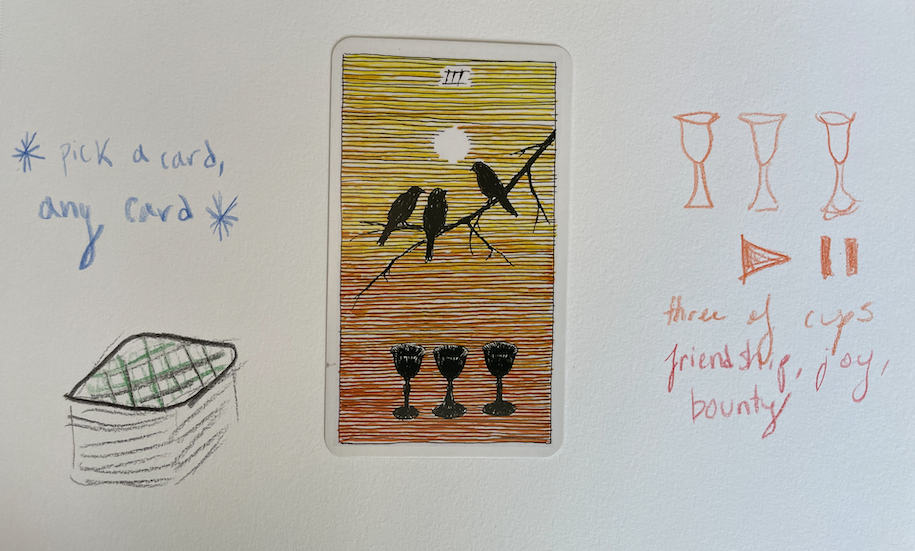
Compose short melodies or rhythms or textures for each tarot card, with some parameters (reverb, LPF cutoff, tempo, pitch) customizable by the user. Idea I might not keep: I will know for which cards they were made, but in the published version they won't necessarily be attached to their original cards. It will be up to the user to identify which card resonates with which melody for them, and having to make that decision will help them become familiar with the tarot. (Unless they don't feel like doing all that work, in which case they could just have my version lol). I would start by making a version of the Wild Unkown tarot which is the deck I use (would I need to get permission from the artist for that? Or just give credit?), but I could also make a version of the classic Rider-Waite deck and link to Biddy Tarot (a really helpful interpretation website) for more information. Could even make it so people could upload their own decks if they have a favorite artist or made their own. OOOOO and when people do readings the music chunks could all combine!! So they could get the vibe of the reading as a whole. For this project I could start with just the major arcana, and then finish in 220B or something.